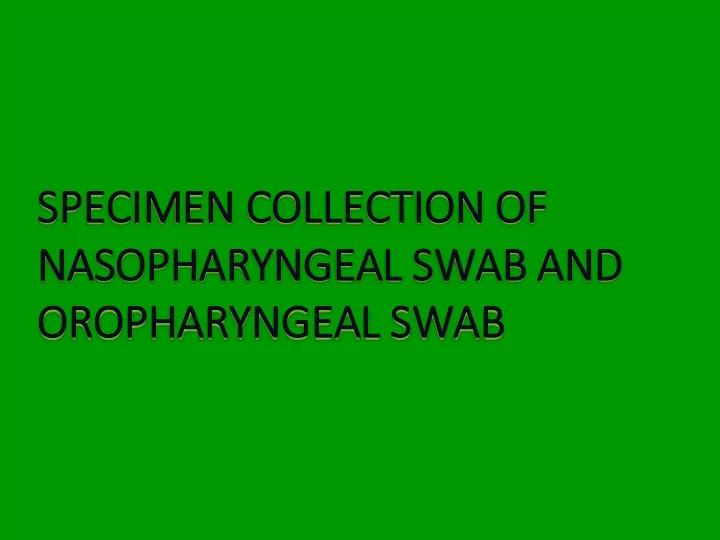

SPECIMEN COLLECTION OF NASOPHARYNGEAL SWAB AND OROPHARYNGEAL SWAB
SUPPLIES/EQUIPMENT NEEDED • COVID-19 Case Investigation Form (CIF) and RITM linelist • Virus Transport Media (VTM) or Universal Transport Media (UTM) or Sample Storage Reagent (Sansure) • Nasopharyngeal swab, Sterile Dacron/Rayon swab with pliable shaft • Oropharyngeal swab, Sterile Dacron/Rayon swab with plastic shaft • Sterile tongue depressor • Test Tube rack • Resealable plastic bags (zip lock) • Laboratory sealing film (parafilm) • Masking tape • Permanent tube marker • Scissors • PPE (Laboratory gown, gloves, N95mask, goggles) • Refrigerator RESEARCH INSTITUTE FOR TROPICAL MEDICINE
COLLECTION KIT • Virus Transport Medium • Nasopharyngeal swab • Oropharyngeal swab RESEARCH INSTITUTE FOR TROPICAL MEDICINE
COPAN SAMPLE COLLECTION KIT IT ⚫ Universal Transport Medium (UTM) or equivalent ⚫ Copan Flocked Swab or equivalent breakpoint
Sa Sample St Storage Reagent (Sa Sansure) an and OPS 5
DIRECTIONS FOR USE OF SWAB • Swabs should not be used if ▪ there is evidence of damage or contamination ▪ the expiration date has passed ▪ the swab package is damaged ▪ there are other signs of deterioration • During sampling, the swab shall only come in contact with the suspected infection. • Do not use excessive force when collecting swab samples from patients as this may result in accidental breakage of the swab shaft. • Swabs are for single use only. RESEARCH INSTITUTE FOR TROPICAL MEDICINE
TECHNICAL NOTES: CORRECT HANDLING OF SWAB Swab held correctly Swab held incorrectly RESEARCH INSTITUTE FOR TROPICAL MEDICINE
Correctly held swab can slide out of the way. Incorrectly held swab can injure patient.
RELEVANT ANATOMY: THE RESPIRATORY SYSTEM
AREA FOR NASOPHARYNGEAL SWAB SAMPLING TARGET SITE FOR NPS RESEARCH INSTITUTE FOR TROPICAL MEDICINE
THE ORAL CAVITY Sensitive to gag reflex TARGET SITE FOR OPS To gain access to the oral cavity, use a tongue depressor RESEARCH INSTITUTE FOR TROPICAL MEDICINE
GUIDELINES PRIOR TO SPECIMEN COLLECTION
INFECTION CONTROL GUIDELINES • Personal protective equipment: wear N95 mask and disposable gloves. • When completed, dispose of all PPE and other contaminated materials in the appropriate trash bin. • Wash hands thoroughly with soap and water or alcohol based hand gel before AND after the procedure.
SPECIMEN COLLECTION POLICIES • Specimens shall be collected within 10 days from onset of illness. • Only qualified and trained staff shall perform the procedures. • Do NOT use wooden and cotton swabs . • Check for integrity of the OPS/NPS swabs and do not use beyond expiration . • Use only the approved kits for specimen collection. RESEARCH INSTITUTE FOR TROPICAL MEDICINE
SPECIMEN COLLECTION POLICIES • Correctly identify the patient and label the UTM tube prior to collection. • Label the tube with the patient’s full name, age and date of collection . The information on the label must MATCH the information on the CIF. • Remove possible visual obstructions. • Strictly follow infection control guidelines prior to each procedure . (Protect yourself from the patient)
SPECIMEN COLLECTION PROPER NASOPHARYNGEAL SWAB (NPS)
• Using the swab, visually measure* from the base of the nostril towards the auditory pit. • Divide the length into half in order to know into what extent will be inserted into the nostril (usually 5–6 cm in adults) to ensure that it reaches the posterior pharynx. *Alternatively, you may use a ruler for more accurate measurements RESEARCH INSTITUTE FOR TROPICAL MEDICINE
NPS: STEP 2 With the patient • seated, tilt the head slightly backwards. Insert the swab into the nostril parallel to the palate RESEARCH INSTITUTE FOR TROPICAL MEDICINE
NPS: STEP 3 • Insert the swab into the nasal cavity until a slight resistance is met. • Rotate the swab and apply a little force to take large quantities of mucosa • Repeat in the other nostril using same swab
NPS: STEP 4 • Place the NPS immediately in the UTM tube to avoid drying of the swab. • Break/Cut the end of the shaft that sticks out of the tube (break point) and close the tube tightly. • Secure the cap with Parafilm to prevent leakage during transport RESEARCH INSTITUTE FOR TROPICAL MEDICINE
NPS: STEP 5 • Transport the specimen to the laboratory and immediately store inside refrigerator(2- 8C) . • If site is far from a refrigerator,use a thermo bag/box with 4-6 icepacks
SPECIMEN COLLECTION PROPER OROPHARYNGEAL SWAB (OPS) RESEARCH INSTITUTE FOR TROPICAL MEDICINE
OPS: STEP 1 • Have the patient seated comfortably. • Have the patient open his mouth. • With gloved hands, hold down the tongue with a sterile tongue depressor • Have the patient say ͞AAH͟ to elevate the uvula
OPS: STEP 2 • Use a sweeping motion to swab the posterior pharyngeal wall and tonsillar fossa. • Avoid swabbing the soft palate. • Do not touch the tongue with the swab tip.
OPS: STEP 4 • Place the OPS immediately in the same UTM with NPS. • Cut the end of the shaft that sticks out of the tube and close the tube tightly. • Secure the cap with Parafilm to prevent leakage during transport.
BEST PRACTICES ✓ Ask patient to remove extra secretions before procedure. ✓ Ask patient to close his or her eyes. ✓ Visually estimate the depth of insertion. ✓ Label the tube first PRIOR to collection. ✓ REMEMBER: Yoursafety first and foremost. RESEARCH INSTITUTE FOR TROPICAL MEDICINE
SPECIMEN COLLECTION POLICIES Sample Storage Reagent (Sansure) Room temperature or 2-8C RESEARCH INSTITUTE FOR TROPICAL MEDICINE
Recommend
More recommend